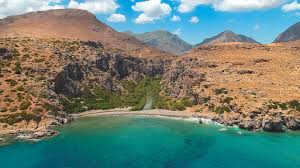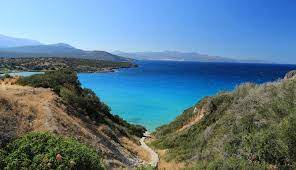

Preveli gorge: Though Preveli gorge (also known as the Preveli Monastery beach) is technically a cliff, if you pass the opportunity to visit this beauty, you’ll never regret it. The beach underneath is tremendously unique, thanks to its natural white sand and clear waters. Palm trees and forest trees are part of the beach – The river from both sides is rich with Palm Trees. The scenery is fantastic!
What to do: The place is still virgin, most people stay a night under the Palm trees, there are sunbeds and a small cafe for refreshments., once you go-you’ll truly understand the definition of ‘sea views’.
How to access Preveli: You can hire a car and drive your self. Rethymnon city is just 1hour and 5minutes far. The beautiful village/town of Plakias is just 25minutes far. Damnoni beach is very close to drive, 25minutes distance from Preveli gorge. Renting a car is the best choise.
PREFACE
 |
The Holy Stavropegiac and Patriarchal Preveli gorge Monastery of Saint John the Theologian (Evangelist), known as the Monastery of Preveli gorge is located at the south of Prefecture of Rethymnon and it is the most sacred part of the Holy Diocese of Lambis and Sfakion, in whose the spiritual jurisdiction belongs. The monastery is consisted of two main building complexes, the Lower (Kato) Monastery of Saint John the Baptist and the Rear (Pisso) Monastery of Saint John the Theologian which is in operation today. The Preveli Monastery and its dependencies cover a large estate land of the Phoenix Municipality towards the Libyan sea and along the Great River (Megalos Potamos), which ends at this point.
The Monastery has a glorious history due to the active and leading involvement of its fellow monks in all national endeavourers for freedom and education of our people. Thus, it merits specific recognition and respect throughout the island of Crete.
In our days, the Holy Monastery of Preveli with a new monastic Brotherhood and through the immemorial coenobitic capitulary of Monachism, wishes, endeavourers and minds to give with a dynamic spiritual and adorable attendance its own orthodox martyry of worship to the God and love to the people, by supporting them to find again their true being meaning through Jesus Christ life.
The Location of the Monastery-Preveli gorge
The expansive site of Preveli Monastery gorge is surrounded by low, wild mountains which form the south – western extension of the White Mountains. The area thus confined, which is linked with the rest of Rethymnon County and Sfakia Province by once inaccessible gorges, comprises a handful of villages which are incorporated into the Phoenix Municipality.
The main access from Rethymnon (in the north) is through a steep gorge, the Kourtaliotis – Preveli gorge. According to the legend, the name is derived from the clinking of stones heard rattling when the north wind blows through this narrow passage. Deep down in the gorge runs the Kourtaliotis river (Preveli gorge), into which other streams in the area flow to form the Great River (Megalos Potamos).
The main springs of the river are virtually in the center of the gorge, near the church of the local saint, St. Nicolaos the Kourtaliotis and it flows into the Libyan Sea, passing through fertile farming sites, at a place called Limni, which is renowned for its beauty. The whole area is quite remarkable for its fertility and the richness of its flora and fauna. The diverse vegetation, including self- planted palm trees, offers an exotic impression to this beautiful landscape.
The area where the Monastery of St. John the Evangelist stands, on the other hand, is almost empty of vegetation because of cattle raising and frequent fires. Nevertheless, the alternating features of the landscape, the magnificent view of the sea, the alternately dry and lush terrain reveal the magnificence of Crete. The panoramic view from the monastery is quite impressive in its austerity, particularly when it meets the Libyan Sea beyond.

